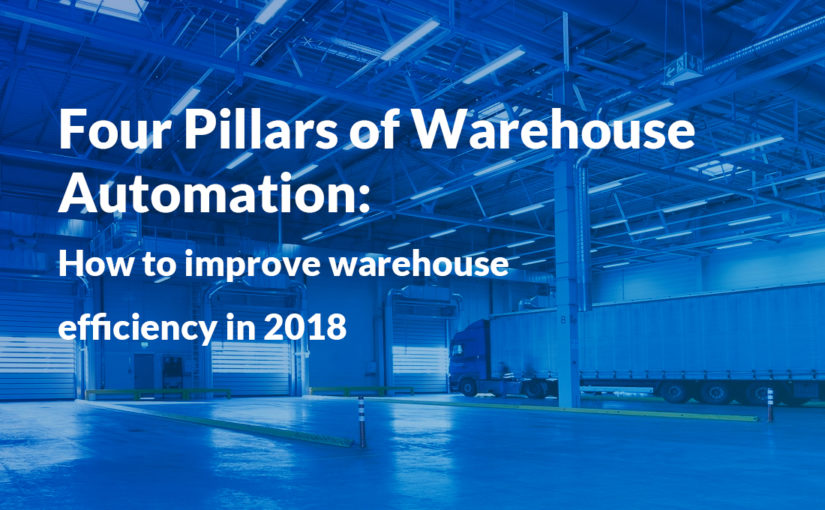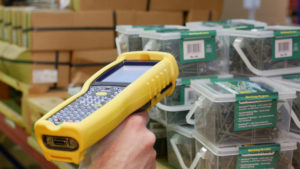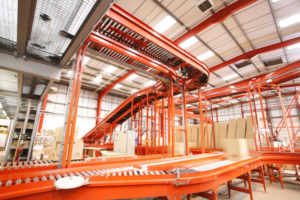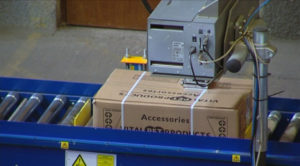With Christmas a distant memory you can now breath a sigh of relief. And if you run a warehouse or logistics operation now is also a good time to ‘take five’ and reflect on how well your operations coped with the increased output demands of the season. Did your warehouse struggle to meet productivity levels? Did you find yourself promising that you’d look for better ways to meet your targets next year?
If you’re one of many businesses in the logistics industry seeking ways to increase warehouse productivity, here’s four fundamental areas to investigate in 2018.
Warehouse automation – how to improve warehouse efficiency:
1. AUTOMATE INVENTORY MANAGEMENT
Invest in warehouse management software
Warehouse management software is key to improving stock traceability and accuracy – both of which will improve efficiency and profitability. From goods-in to dispatch you need to be able to track all items in your warehouse and automating the process can be the answer. Even basic warehouse management software will improve the overall efficiency of your stock control management procedures.
By combining warehouse management software with barcode scanning technology you’re able to log all products and track them through the warehouse, giving you full visibility of their journey.
A key benefit of any warehouse management software is the data it produces and stores. This gives you valuable insights to help you manage your warehouse in the most efficient manner. For example, you can:
- Improve order fulfilment rates due to accurate stock levels
- Identify the fastest moving seasonal items and locate them for optimum picking productivity
- Rotate stock in an ordered and logical manner
2. IMPROVE PICK RATES
Automate warehouse picking
Measured in time and cash – order picking is, without a doubt, the most excessive activity in the running of a warehouse. Therefore streamlining and accelerating your picking processes will bring big cost savings. In a study conducted by Dematic, it was proved that by simply optimising pick paths you can typically increase pick speed by 10 to 18%.
Review your picking methodology and ensure it suits your business model. Whether it’s sequencing orders by pick path, batching together single lines, or using zone picking, you could save a huge amount of time by matching your pick and pack methods to your order profiles.
If you have warehouse management software this will help inform the best picking methods. For example it could identify regular lines that get ordered and packed together, so zone picking could be introduced.
However, increasing pick rates can be a ‘catch twenty-two’ situation – how do you speed up your pickers’ pick-rates without reducing their accuracy? The answer is to automate the process by introducing automated pick routing to remove as much of the manual ‘thinking’ process as possible.
At a more advanced level, warehouse management software can generate automated pick lists – providing pickers with the most efficient routes around the warehouse, ensuring the fastest pick and pack times possible.
3. REDUCE THE MANUAL MOVEMENT OF GOODS
Introduce automated conveyor systems
Using automated conveyor systems to move items around a warehouse can be one of the single best ways to become more efficient. Replacing manual handling with automated systems will help make the workplace a safer place and your employees’ jobs less labour intensive.
There are many types of automated conveyor systems to suit different uses – from box conveyors, to pallet conveyors, belt conveyors to in-floor conveyors. A conveyor specialist will find a solution to efficiently move almost any item around your warehouse. And if a conveyor is not suitable, then they will suggest a different technology, such as autocars or automated guided vehicles.
As well as moving products from location A to location B, conveyors can be linked to intelligent controls systems that will use programmed logic and barcode scanners to carry out a range of activities including:
- Transporting goods straight to pickers to pack
- Sorting goods (based on order, size, weight, delivery location etc) onto the relevant dispatch lines, ready for packing and loading
Don’t let space be an obstacle. There are many ways to make the most of the space available, including using overhead conveyors and incline/decline conveyors, spiral conveyors and pallet elevators to transfer items between levels.
4. REMOVE LABOUR-INTENSIVE TASKS
Consider automated material handling processes
By automating basic, repetitive tasks you can improve the accuracy of your operations, reduce labour demands and boost warehouse productivity.
Simple activities such as printing and applying labels, taping and strapping boxes, and adding dispatch notes can be done whilst items are on a conveyor – without any need for manual intervention.
TAKE A REALITY CHECK!
For many small and medium-sized businesses the cost of fully automating a warehouse – in one go – may be unrealistic. So consider partial automation. Invite warehouse automation consultants into your business to carry out an audit of your site and identify the areas where automation will offer the biggest benefits. Prioritise these first – reap the rewards and then invest in further.
If you’d like to discuss how to automate your warehouse, please contact us for a free initial consultation.
Keymas are a conveyor systems and automation company. Contact us today to find out how we can help automate your business
Contact Us




